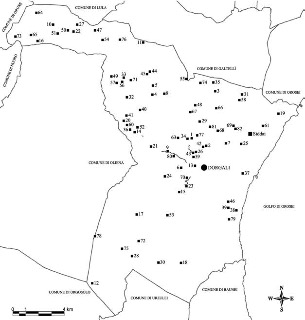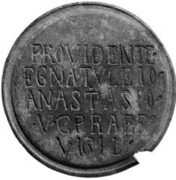The territory of Dorgali during Roman Times
The occupation of the territory of Dorgali during the Roman and Late-Ancient Ages is clearly documented in over eighty sites by artefacts (figs. 1, 2, 3) and masonry structures.

From the second century B.C. up until the fourth century A.D., the phenomenon of reusing existing Nuraghic sites is very frequent, and typical of the process of Romanisation which took place as a result of the difficult Roman conquest of central-eastern Sardinia, which occurred between the mid-third century and the end of the second century B.C.


One of the places it is necessary to refer to in order to define the history of the landscape and the geography of the area, is that of the Roman station of Viniolae, in the countryside of Dorgali (which is now identified with the site of Finiodda in the Valley of the Oddoene), cited in Antonine’s itinerary, and located along the iter a Portu Tibulas Karalis, i.e. on the road which developed along the east coast of Sardinia, and along which most of the known Roman settlements are located. Other sites have been identified at the two intersecting branches directed inland, in the direction of the valley of Isalle and Oliena, towards inner Barbagia.
Bibliografia
- BONINU A., Testimonianze di età romana nel territorio di Dorgali, in AA.VV., Dorgali. Documenti archeologici, Sassari 1980, pp. 221-239.
- DELUSSU F., Nuraghe Mannu (Dorgali, Nu): scavi dell’abitato tardo-romano e altomedievale (campagne 2005-2006), in FastiOnline, 165, 2009, pp. 1-13.
- DELUSSU F., IBBA A., Egnatuleius Anastasius: un nuovo praefectum vigilum da Dorgali, in L’Africa Romana. Trasformazione dei paesaggi del potere nell’Africa settentrionale fino alla fine del mondo antico, Atti del XIX Convegno di Studio, Sassari 16-19 dicembre 2010, II, Roma 2012, pp. 2195-2210.
- MANUNZA M. R., Dorgali. Monumenti antichi, Oristano, 1995, pp. 199-219.
- MORAVETTI A. (a cura di), Carbonia-Fonni, in La Sardegna. I Tesori dell’Archeologia, La Biblioteca della Nuova Sardegna, vol. 3, Sassari 2011, p. 77.
- PULACCHINI D., Il museo archeologico di Dorgali, Sardegna Archeologica. Guide e itinerari, 27, Sassari 1998.
- TARAMELLI A., Edizione archeologica della Carta d’Italia, Foglio 208 (Dorgali), Firenze 1929.
- TARAMELLI A., Dorgali (NU). Esplorazioni archeologiche nel territorio del Comune, in Notizie degli Scavi, IX, 1933, p. 370, 378, figg. 23-32.

 VR
VR